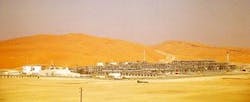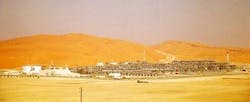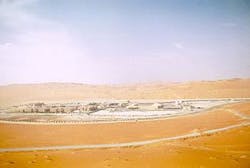Shaybah oil field, Saudi Arabia's newest supergiant, is approaching its sixth anniversary yet still is growing in terms of reserves and potential productive capacity.
Although the official reserves estimate for Shaybah is 14 billion bbl, project managers with operator and state oil company Saudi Aramco contend that their efforts have proved up as much as 15.7 billion bbl. One project engineer confided to OGJ his conviction that the number could easily climb to 18 billion bbl, given the company's recent successes with appraisal drilling and more-detailed 3D seismic surveys. And the field is proving prolific even in other ways, as Aramco last month reported a new gas pool discovery in the heart of the field (see related story, this page).
Shaybah, in the Rub' al Khali basin at the eastern edge of Saudi Arabia's vast Empty Quarter deep-desert region, currently produces about 560,000 b/d of oil. That's down 30,000 b/d from what it had produced most of the time since start-up in July 1998—a cut ordered to accommodate the new Saudi production quota implemented under an Organization of Petroleum Exporting Countries agreement early this year. Scheduled field maintenance is expected to reduce output further to 450,000 b/d during April-June.
But even those levels are is just a fraction of the field's production potential. Both the Shaybah engineers and Saudi Minister of Petroleum and Mineral Resources Ali al-Naimi told OGJ that a ramp-up to 1 million b/d is feasible for the field.
"Should the demand [for the added increment of production] materialize—Shaybah is, I think, depleted at the rate of 1%[/year], which is low—with reserves of over 14 billion bbl, another increment of 500,000 [b/d] is feasible," Al-Naimi told OGJ in an interview in Riyadh (see related story, p. 18). "It's not a big deal."
Shaybah produced its 1 billionth bbl of oil on Dec. 25, 2003; by that time, another 2.5 billion bbl had been added to the reserves column from further field delineation and development.
null
null
Project details
The $2.5 billion complex features three gas-oil separation plants (GOSPs), with the central production facility, operations center, and living quarters near GOSP 2. It is 800 km southeast of Dhahran, Aramco headquarters. The field lies amid sand dunes more than 200 m tall in a region occasionally scoured by sandstorms with 75 mph winds. Over 100 million cu m of sand were removed for the project's airstrip alone.
The project facilities took 18 months to construct, and it took 3 years from start of production design in July 1995 to start-up. Each of the GOSPs has two dehydration units and two desalters. Produced water is treated to drinking quality standards and reinjected at the rate of 300 gpm. Recovered LPG fuels the field's electricity complex, which consists of four generator sets supplying 60 Mw of power each; two of the power units are redundant.
The field produces 42º gravity Arab Extra Light crude oil from Shuaiba pay at an average depth of 4,650 ft. The crude is virtually sulfur-free and so high in its gasoline fraction that, during construction, crude occasionally was used directly from the wellhead to fuel bulldozers.
It was designed to be economically productive with 170 wells, but advances in horizontal well technology have improved the picture to 100 wells. Initially in 1996, Shaybah horizontals in South Shaybah yielded on average 3,000 b/d with a 1 km reservoir contact. By 2002, the use of multilaterals that included quad-lateral and fishbone designs boosted that to as much as 10,000 b/d and 12.3 km of reservoir contact. Reservoir permeability averages 13 md. Today, an average horizontal well at Shaybah produces 7,000 b/d. The advances have allowed a threefold reduction in unit development costs at Shaybah. At least 13 multilateral wells have been drilled in the field, some with as many as 8 branches. Aramco engineers said the improvements allow the company to achieve cost recovery on a typical $3 million Shaybah well in 31 days. Another 25 vertical wells have been drilled in the field to serve as observation wells.
Shaybah GOSPs are served by 12 flowlines linked to 5-7 wells each. Wells are not produced to maximum potential but to maintain "homogeneous production" under Aramco's maximum sustained capacity rules.
Shaybah crude is partially stabilized and shipped to Abqaiq where some residual gas and NGLs are stripped out of the production stream before entering Aramco's oil pipeline system via a 46-in., 600,000 b/d capacity, 630 km pipeline equipped with four pumps and no interim pumping station.
Shaybah also has a massive gas cap, with reserves estimated at 25 tcf. Gas production is 600 MMcfd, which is reinjected along with NGLs. The initial development scheme did not include plans to market the gas, and Aramco project managers said that building a gas line to Abqaiq would have undermined the economics of the original project.
Plans call for a fourth compression plant by 2007 to boost gas reinjection to as much as 880 MMcfd.
Aramco engineers said there is a possibility of implementing an NGL recovery scheme within 5-6 years.




